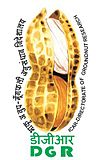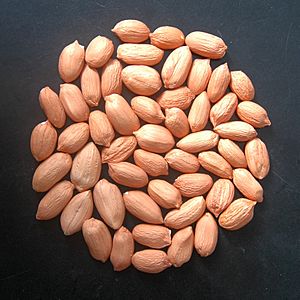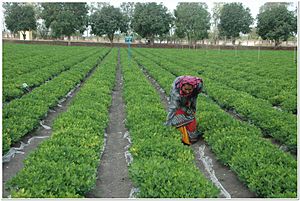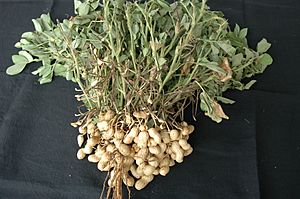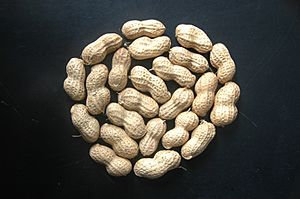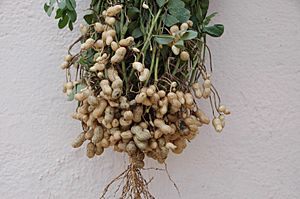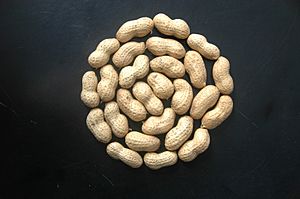Directorate of Groundnut Research facts for kids
The ICAR - Directorate of Groundnut Research (ICAR-DGR) is a special research center in India. It used to be called the National Research Centre for Groundnut. This institute helps farmers grow better groundnuts, also known as peanuts.
It was set up in 1979 in Junagadh, Gujarat. The main goal was to improve how much groundnut farmers could grow. This is important because groundnut is a key oilseed crop in India. The ICAR-DGR is part of the Indian Council of Agricultural Research. This council helps guide farming research across India.
Contents
History of ICAR-DGR
ICAR-DGR was the first national research center in India focused on a single crop. It started on October 1, 1979. The first location was in Junagadh on land rented from Gujarat Agricultural University.
Later, on October 1, 1991, the center moved to a new, larger site. This new place was about 4 kilometers away. It had much more land, about 100 hectares, from Junagadh Agricultural University. In 2009, the center became a "Directorate" to show its growing importance.
What ICAR-DGR Does
The main jobs of the ICAR-DGR are:
- To do research on groundnuts to make them grow better. This includes improving their quality.
- To share information, knowledge, and special groundnut seeds. This helps create new and better types of groundnuts.
- To work with others on research. This helps develop groundnut types and methods for specific areas.
- To teach farmers and others about new groundnut growing techniques.
ICAR-DGR's Big Goal
The main goal of ICAR-DGR is to help India grow more groundnuts. They want to increase the amount of groundnuts harvested per hectare. For farms that rely on rain, they aim for 3000 kg per hectare. For farms with irrigation, they aim for 4000 kg per hectare.
They do this by using different types of research. This research helps farmers grow groundnuts in a way that is profitable and good for the environment.
Research Divisions
The ICAR-DGR has five main groups, or divisions. Each division has its own special tasks.
Crop Production
This division studies how to grow groundnuts better. They work on:
- Finding the best ways to grow groundnuts in different farming systems.
- Managing problems like salty soil or not enough water.
Crop Protection
This division focuses on keeping groundnuts healthy. They work on:
- Finding ways to control pests that harm groundnuts.
- Preventing harmful substances, like toxins, from growing on groundnuts.
Crop Improvement
This is a major division that works on making groundnut plants better. They use genetics, plant breeding, and biotechnology. Their main projects include:
- Developing groundnuts that can handle diseases, pests, or tough weather.
- Keeping a collection of groundnut seeds and their wild relatives. This is like a "gene bank."
- Using advanced science to improve groundnuts.
- Breeding groundnuts with larger seeds or special types for snacks.
- Using genes from wild groundnut plants to improve farmed ones.
- Improving groundnuts for better animal feed.
They have a special groundnut Gene bank and a biotechnology lab for this work.
Basic Sciences
This unit does deeper scientific studies. They look at:
- How groundnuts react to stress from the environment.
- How to give groundnuts the right nutrients from the soil.
- The role of tiny living things (microorganisms) in soil health.
- Checking and improving the quality of groundnuts and products made from them.
- Turning groundnut waste into useful products.
Social Sciences
This is the newest unit. It looks at the human side of groundnut farming. They study:
- How much it costs to grow groundnuts in different areas.
- How new groundnut farming methods help farmers' lives.
- Using math and statistics to understand groundnut farming data.
All India Coordinated Research Project on Groundnut (AICRP-G)
The ICAR also runs a big project called the All India Coordinated Research Project on Groundnut (AICRP-G). This project helps coordinate groundnut research across the whole country. It started in 1992.
The AICRP-G works from the ICAR-DGR in Junagadh. It gets special funding from the ICAR. This project divides India into five zones based on climate. Researchers from different universities and institutes work together. They develop new groundnut types and farming methods for each zone.
What AICRP-G Does
The AICRP-G has several important tasks:
- They do research on improving groundnut plants, how to grow them, and how to protect them. This happens at many centers across India.
- They develop new groundnut types that can resist drought, diseases, pests, heat, or bad soil.
- They create farming methods that help farmers get the most from their groundnut crops.
- They show farmers how to use new technologies through demonstrations on farms.
- They find strong groundnut types that can resist problems and use them to create even better varieties.
- They produce special "nucleus" and "breeder" seeds for important groundnut types.
Images for kids



